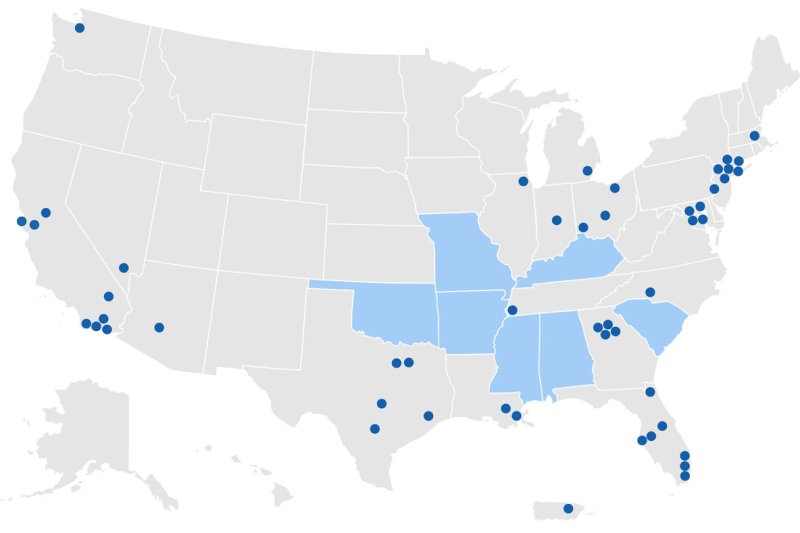A map of 48 counties targeted for specific attention under a federal plan to drive down HIV/AIDS infections by 90 percent by 2030. Image courtesy U.S. Department of Health and Human Services
Feb. 6 (UPI) -- President Donald Trump during his state of the union speech on Tuesday announced his intention to end the HIV epidemic in the United States over the next decade.
Following Trump's announcement, Health and Human Services officials on Wednesday laid out details of the plan, including the intention to target 48 counties where roughly half of new diagnoses are reported, in addition to other efforts to bring down the number of people contracting the deadly disease.
"HIV has cost America too much for too long We have lost 700,000 American lives since 1981," Brett P. Giroir, Assistant Secretary for Health at Health and Human Services, said during a conference call with reporters. "And unfortunately, despite the emergence of new tools and new techniques, we are at high risk of another 400,000 Americans becoming infected with HIV over the next decade."
The agencies within HHS will focus on counties in urban areas like Los Angeles, Miami, Houston, Chicago, Dallas, Fort Lauderdale, Brooklyn, Atlanta, Phoenix and the Bronx to reduce and ultimately stop the spread of HIV, officials said.
The highest concentration of HIV cases are among gay men, black people, American-Indians, Alaska Natives and people living in the south. In 2017, 52 percent of the HIV diagnoses were in southern states, according to the Centers for Disease Control and Prevention.
The goal of the plan is to reduce HIV transmission rates by 75 percent in five years and by 90 percent by 2030.
The plan will also address needs in rural states such as Alabama, Arkansas, Kentucky, Mississippi, Missouri, Oklahoma and South Carolina.
Much of the strategy will include increasing diagnoses of HIV through aggressive testing in the targeted communities. Of the 1.1 million people in the U.S. living with HIV, one in seven is unaware they are infected.
Use of PrEP, a drug that prevents the transmission of HIV from an infected person with the virus to someone without it, is expected to increase as part of the plan. The medication can prevent HIV transmission in over 95 percent sexual encounters, according to previous research.
"As you all know, if you treat an individual and bring their viral loads below detectable levels, they will not transmit their virus to another individual. And we know the PrEP works in 97 percent of cases," said Anthony S. Fauci, Director, National Institute of Allergy and Infectious Diseases. "If you get everyone who's infected on anti-retroviral and get everyone who needs it PrEP, you can theoretically end the epidemic as we know it"
About 1.2 million people are at a high-risk level for PrEP, but only 10 percent of them take the medication.
The plan will also ramp up efforts of the Ryan White HIV/AIDS program, which offers primary care to uninsured and underserved low-cost HIV patients. The program has worked to suppress viral loads for nearly 86 percent of its clients.
"We'll be engaging directly with the state, local, tribal and territory health departments, and obviously also engaging with community members," Robert R. Redfield, Director for Centers for Disease Control and Prevention, said during the call. "Clearly, there's a plan to augment personnel to have greater capacity to help navigate people into care and into PrEP."
It's estimated that one in two people with HIV has been infected for three years and one in four has been infected for seven years, Redfield says.
Between 2012 and 2016, the U.S. averaged about 40,000 HIV diagnoses each year, the CDC reported.
About 10 percent of HIV cases result from IV drug use.
The high cost of opioids often drives users to seek out cheaper alternatives like heroin to get high. Most heroin use is administered by a needle, use of which can increase risk for the spread of HIV and AIDS.
"We are fully supportive of comprehensive syringe programs, which have been shown by the data to decrease the transmission of HIV, hepatitis C, and other viruses, as well as having a substantial impact on channeling those with opioid use disorder into treatment and into recovery," Giroir said. "The data are very clear, there's about an increase in long-term recovery if you're treated in one of these comprehensive programs."















